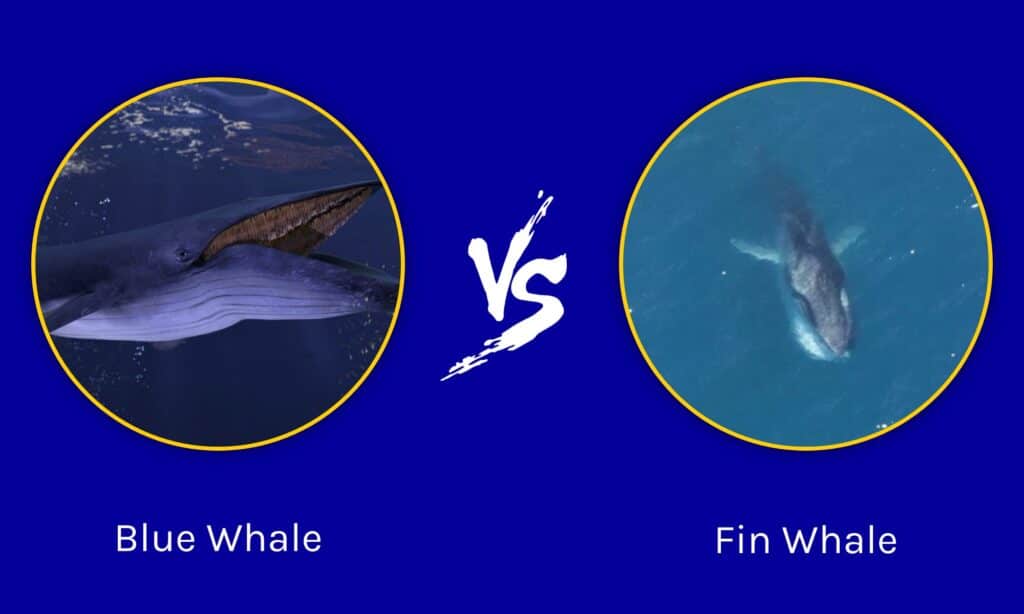Whales are the largest creatures that currently live in the oceans of the world. In fact, whales are the largest creatures to ever live on earth in the history of life! Larger than dinosaurs, ice age megafauna, and more, these amazing creatures are alive and able to be witnessed by humans today. Two of the largest species of whale are the blue whale and fin whale. Although these whales are extremely similar, there are some distinct differences between the two. Today, we are going to explore these differences when we compare the Blue Whale vs Fin Whale!
Comparing a Blue Whale and a Fin Whale

| Blue whale | Fin whale | |
|---|---|---|
| Size | Length: Up to 98 feet long Weight: 199 metric tons (438,720 lbs) | Length: Up to 85 feet long Weight: 80 metric tons (176,370 lbs) |
| Appearance | Long, slender body. Mottled blue-gray body. Broad, flat head. | Long, slender body. Brown-grey with pale belly. Pointed head. |
| Population Size | 10,000-25,000 individuals. | 100,000-119,000 individuals. |
| Whaling history | Targeted beginning in the 1860s. Hunted to near extinction. Isn’t hunted at scale today. | Heavily hunted in the late 19th and 20th centuries. Currently, only Iceland and Japan actively hunt fin whales. |
| Conservation status | Endangered. | Vulnerable. |
The 5 main differences between a blue whale and a fin whale
The main differences between a blue whale and a fin whale are that blue whales are larger, are blue-gray, and have a significantly smaller population than fin whales.
Blue and fin whales are the two largest animals that currently exist on earth. Although the blue whale is a bit longer and a lot heavier, these animals are closely related. As it stands, blue whales are the largest creatures to have ever lived on earth, meaning fin whales are the second-largest creatures to have ever lived on earth. Still, in the battle of the behemoths, the blue whale is king.
Size aside, both the blue whale and fin whale are baleen whales that have somewhat similar appearances. Both are long and slender animals, designed to extreme distances through marine environments. Fueling these marine mammals is their large mouths filled with layers of baleen shafts. Baleen whales don’t have teeth, and instead filter water through “whiskers” that can pass water, but trap small ocean animals. On average, blue and fin whales can eat over 10 tons of food each day.
Aside from psychological differences between these animals, their history and interactions with humans are a bit different. Both whales had their populations drastically reduced to widespread whaling practices during the 19th and 20th centuries. Despite the last major whaling operations ceasing in the 1970s, neither whale population has fully recovered. Still, between the two, blue whales are still hanging on by a thread while fin whales have a much larger and more stable population.
In addition to these differences, blue and fin whales differ in some other areas. Let’s explore their differences in a bit more detail below.
Blue Whale vs Fin Whale: Size

Blue whales are the largest animals on earth, while fin whales are the second-largest animals on earth.
©Atomic Roderick/Shutterstock.com
The blue whale is the largest animal to have ever lived on earth. These massive animals can measure up to 98 feet, although some reports have the surpassing even 100 feet. Additionally, blue whales can weigh nearly 200 metric tons, a number which is hard to truly understand. At 199 metric tons (nearly half a million pounds), blue whales weigh as much as 175 Hyundai Accents stacked on one another.
Fin whales are also incredibly large, just not as large as blue whales. A fin whale can measure up to 85 feet long and weigh up to 114 metric tons. On average, fin whales weigh around 74 metric tons, but some large individuals have been recorded at around 80 tons. Although the blue whale is the largest animal in the world, the fin whale is a close second.
Blue Whale vs Fin Whale: Appearance

Fin whales are brown-gray.
©Bawolff – Public Domain – License
The blue whale gets its name from the mottled blue-gray appearance that its thick skin has. In the water, however, the mottled pattern usually just looks deep blue. These whales are long and slender, perfectly designed for long-distance travel across the oceans of the world. Besides the color, the best way to tell the difference between a blue and a fin whale is their head shape. Blue whales have broader, flatter heads that are U-shaped when seen from above.
Fin whales are also slender, potentially even more so than blue whales. These animals are silver, gray, or gray-brown in color and have a lighter-colored belly that is usually pale white. Where the heads of blue whales are flat and U-shaped, fin whales are generally more pointed and sleek.
Blue Whale vs Fin Whale: Population size

There are 10-25,000 blue whales left in the world and 100-119,000 fin whales left in the world.
©Gregory “Slobirdr” Smith / CC BY-SA 2.0, Flickr – License
Currently, blue whale populations are estimated to be between 10,000-25,000 globally. There are four subspecies of blue whales, each with its own regional population group. The four subspecies of blue whales are the northern subspecies, the northern Indian Ocean subspecies, pygmy blue whales, and the Antarctic subspecies.
The fin whale has an estimated 100,000-119,000 individuals left globally. There are five major populations that are listed. These population groups include the North Atlantic population, the Mediterranean Sea population, the North Pacific population, the South Pacific population, and the Antarctic population of fin whales.
Blue Whale vs Fin Whale: Whaling history

The blue and fin whales were nearly hunted to extinction in the 20th century.
©Annie Douglas – Public Domain – License
Both the blue and fin whales have an extensive and bloody history in regards to whaling. The practice is quite gruesome and has negatively impacted both of these species to the point of near extinction.
Historically, blue whales weren’t hunted due to their size and a human’s inability to kill them. That all changed when the exploding harpoon gun was invented in 1864, and humans could finally target the giants of the ocean. Soon, over 30,000 individuals were killed each year. The practice was banned in 1966 when the IWC (International Whaling Commission) put a stop to the killing of blue whales. The pre-whaling estimates for blue whale populations were likely around 350,000 individuals, meaning over 99% of all blue whales were wiped out during a period of 100 years.
Fin whales were also heavily hunted when the exploding harpoon gun was created. As other species of whale began to disappear, hunters turned to the fin whale to make up for their losses. The primary hunting grounds for the fin whale were in the southern Antarctic waters, with over 725,000 whales taken just in the southern hemisphere between 1905 and 1976. By the end of the IWC’s allowance on fin whale hunting, only 38,000 individuals remained. Currently, Japan and Iceland still actively hunt the fin whale.
Blue Whale vs Fin Whale: Conservation status
The IUCN lists the blue whale as Endangered. Boat strikes, pollution, and climate change still pose a serious threat to blue whale populations globally.
The IUCN lists the fin whale as Vulnerable. Fin whales are still hunted by Japan and Iceland. Additionally, boat strikes, climate change, and pollution negatively impact the fin whale.
The photo featured at the top of this post is © Andrew Sutton/Shutterstock.com
Thank you for reading! Have some feedback for us? Contact the AZ Animals editorial team.






